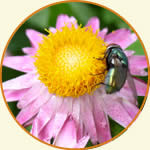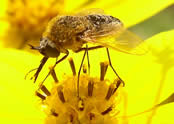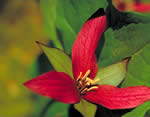USDA Forest Service Celebrating Wildflowers
|
|
|
Fly PollinationThe two-winged insects (flies, gnats, mosquitos) is a very large group. Many of them specifically visit flowers, such as the Syrphid flies or flower flies. They are not as hairy as bees and as efficient in carrying pollen, but some are good pollinators. Fly FlowersThe flowers that are pollinated by flies are typically:
Bee MimicsSome flies, such as syrphids, masquerade as bees and wasps. However, the pollinating flies can be distinguished with a sharp eye. The flies have only one pair of wings while bees and wasps have two pairs of wings. Comical, robust and extremely hairy are the bee flies (bombylids), some with tongues as long as their bodies! Putrid OdorPutrid smelling blossoms are an adaptation to attract certain fly pollinators. Even male mosquitoes (relatives of flies) get in on the act since they pollinate certain orchids. Long-tongued flies (e.g., syrphids, bombylids) feed on same flower types that bees do. Short-tongued flies feed on flowers that imitate the main source of food for flies. Flies may be trapped for a time in the flower while they feed; e.g. Stapelia, Dutchman’s pipe.
Rotten Meat?Red Trillium is a beautiful flower with a less than beautiful odor. Many wildflower enthusiasts claim that this flowering beauty smell like rotting flesh. Although humans may not find this smell attractive, flies are drawn to these brilliant red blooms. The deep red color and putrid odor resemble decaying meat and attract flies who feed on pollen of these flowers. Typically, no nectar is produced in fly-pollinated flowers. This carrion-scented flower is also known as “Stinking-Benjamin” or birthroot. A Fly’s Worst FriendDogbane is a common pink flowered shrubby herb that flowers in July and August. Dogbane flowers are designed to attract butterflies. When these long-tongued pollinators visit the flowers of dogbane, their tongues become coated with a pollen and cement like mixture from the flower. Flies and weaker insects are not so lucky. These lightweight pollinators often become glued to the flower and die a slow death from starvation. The Midge and the Chocolate LoverWhat does a midge have to do with chocolate? More than you think. Chocolate comes from cocoa trees. that grow in the tropics. These trees look quite different from most other plants. Instead of having flowers in the most conspicuous places, they have them on the trunk and lowest branches. These flowers are small and white and face down, the reason for all this is that they attract tiny flies, known as midges rather than bees or other better-known pollinators. The midges are ordinarily attracted to fungus and cocoa flowers smell somewhat mushroomy, too. In essence, for the cocoa tree to bear fruit, first it has to be pollinated by midges. Think about it next time that you eat a bite of that marvelous thing known as chocolate. |
|
| Ants | Bats | Bees | Beetles | Birds | Butterflies | Flies | Moths | Unusual | Wasps | Wind & Water | |
| NOTE: PDF format links require the Adobe Acrobat Reader to view. | |
| top | Disclaimers | FOIA | Privacy Policy | Quality of Information | Photo Credits & Use |
Location: http://www.fs.fed.us/wildflowers/pollinators/flies.shtml
Last modified: Tuesday, 20-May-2008 15:56:16 EDT











